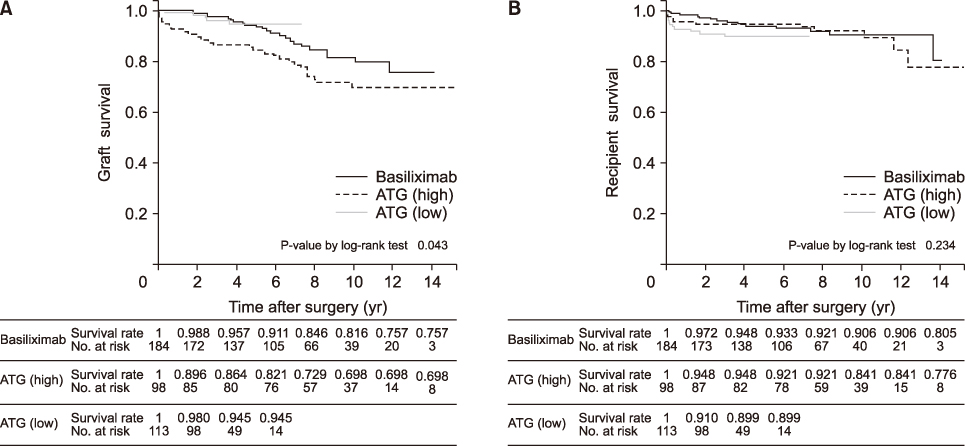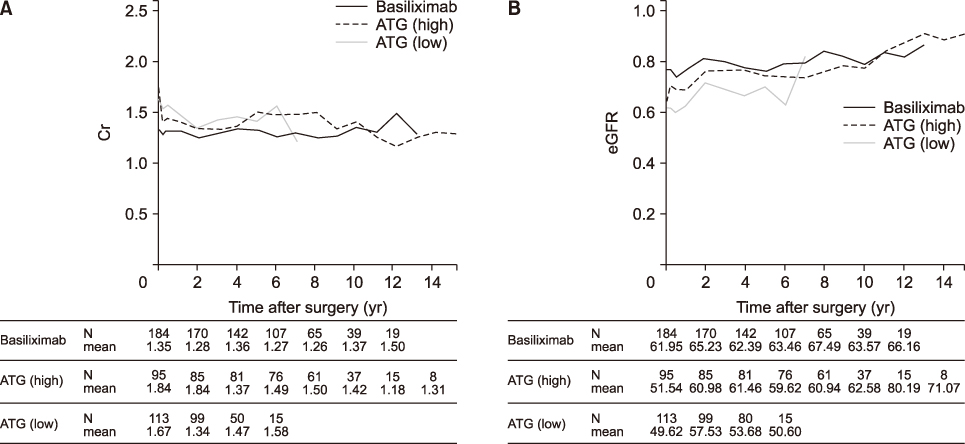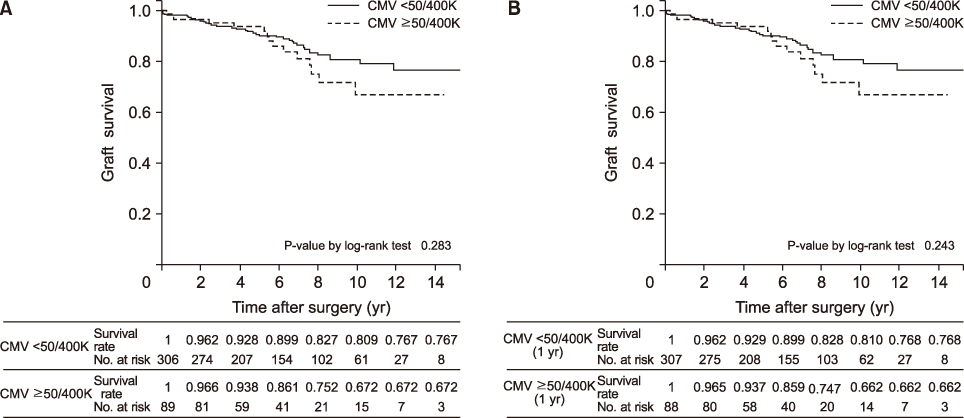Korean J Transplant.
2019 Dec;33(4):118-127. 10.4285/jkstn.2019.33.4.118.
Comparison of clinical outcomes of deceased donor kidney transplantations, with a focus on three induction therapies
- Affiliations
-
- 1Department of Surgery, Samsung Medical Center, Sungkyunkwan University School of Medicine, Seoul, Korea. kw1980.lee@gmail.com
- 2Biostatistics and Clinical Epidemiology Center, Samsung Medical Center, Seoul, Korea.
- KMID: 2468162
- DOI: http://doi.org/10.4285/jkstn.2019.33.4.118
Abstract
- BACKGROUND
Graft survival rate of kidney transplantation recipients improves after induction therapy. However, there is no conclusive evidence on which regimen is superior for deceased donor kidney transplantation (DDKT). This study aims at discussing effective induction therapy in DDKT.
METHODS
Between 2003 and 2016, 395 DDKT recipients were divided into three groups following induction therapy. Recipients of the basiliximab group (n=184) received basiliximab (20 mg/kg) on days 0 and 4. Recipients of the low-dose rabbit anti-thymocyte globulin (rATG) group (n=113) received rATG (1.5 mg/kg) on days 0, 1, and 2, while those of the high-dose rATG group (n=98) received it for more than 4 days. We retrospectively reviewed and analyzed the clinical outcomes and adverse effects of induction therapy.
RESULTS
Compared to other groups, the low-dose rATG group donors were older (P<0.001); rATG group donors had higher serum creatinine levels (P<0.001), and the basiliximab group showed a lower delayed graft function rate (P=0.004). In graft failure, the low-dose rATG group did not differ significantly from the basiliximab group (P=0.080), but was significantly different from the high-dose rATG group (P=0.004).
CONCLUSIONS
The low-dose rATG group had the best graft survival rate, although it had older donors and higher serum creatinine levels. Therefore, low-dose rATG may be considered an effective induction therapy in DDKT.
MeSH Terms
Figure
Cited by 1 articles
-
Impact of delayed graft function on clinical outcomes in highly sensitized patients after deceased-donor kidney transplantation
Seong Gyu Kim, Suyeon Hong, Hanbi Lee, Sang Hun Eum, Young Soo Kim, Kyubok Jin, Seungyeop Han, Chul Woo Yang, Woo Yeong Park, Byung Ha Chung
Korean J Transplant. 2021;35(3):149-160. doi: 10.4285/kjt.21.0014.
Reference
-
1. Hariharan S, Johnson CP, Bresnahan BA, Taranto SE, McIntosh MJ, Stablein D. Improved graft survival after renal transplantation in the United States, 1988 to 1996. N Engl J Med. 2000; 342:605–612.
Article2. Hariharan S. Long-term kidney transplant survival. Am J Kidney Dis. 2001; 38:6 Suppl 6. S44–S50.
Article3. Bourdage JS, Hamlin DM. Comparative polyclonal antithymocyte globulin and antilymphocyte/antilymphoblast globulin anti-CD antigen analysis by flow cytometry. Transplantation. 1995; 59:1194–1200.
Article4. Zand MS, Vo T, Huggins J, Felgar R, Liesveld J, Pellegrin T, et al. Polyclonal rabbit antithymocyte globulin triggers B-cell and plasma cell apoptosis by multiple pathways. Transplantation. 2005; 79:1507–1515.
Article5. Amlot PL, Rawlings E, Fernando ON, Griffin PJ, Heinrich G, Schreier MH, et al. Prolonged action of a chimeric interleukin-2 receptor (CD25) monoclonal antibody used in cadaveric renal transplantation. Transplantation. 1995; 60:748–756.
Article6. Gralla J, Wiseman AC. The impact of IL2ra induction therapy in kidney transplantation using tacrolimus- and mycophenolate-based immunosuppression. Transplantation. 2010; 90:639–644.
Article7. Castro MC, Araujo LM, Nahas WC, Arap S, David-Neto E, Ianhez LE. Induction versus noninduction therapy in kidney transplantation: considering different PRA levels and different induction therapies. Transplant Proc. 2004; 36:874–876.
Article8. Ferrer F, Machado S, Alves R, Macário F, Bastos C, Roseiro A, et al. Induction with basiliximab in renal transplantation. Transplant Proc. 2010; 42:467–470.
Article9. de Fijter JW. Rejection and function and chronic allograft dysfunction. Kidney Int Suppl. 2010; (119):S38–S41.
Article10. Yarlagadda SG, Coca SG, Formica RN Jr, Poggio ED, Parikh CR. Association between delayed graft function and allograft and patient survival: a systematic review and meta-analysis. Nephrol Dial Transplant. 2009; 24:1039–1047.
Article11. Narayanan R, Cardella CJ, Cattran DC, Cole EH, Tinckam KJ, Schiff J, et al. Delayed graft function and the risk of death with graft function in living donor kidney transplant recipients. Am J Kidney Dis. 2010; 56:961–970.
Article12. Brennan DC, Daller JA, Lake KD, Cibrik D, Del Castillo D. Thymoglobulin Induction Study Group. Rabbit antithymocyte globulin versus basiliximab in renal transplantation. N Engl J Med. 2006; 355:1967–1977.
Article13. Lee KW, Park JB, Cho CW, Lee N, Yoo H, Kim K, et al. The impact of donor-specific anti-Human Leukocyte Antigen (HLA) antibody rebound on the risk of antibody mediated rejection in sensitized kidney transplant recipients. Ann Transplant. 2017; 22:166–176.
Article14. Chen G, Gu J, Qiu J, Wang C, Fei J, Deng S, et al. Efficacy and safety of thymoglobulin and basiliximab in kidney transplant patients at high risk for acute rejection and delayed graft function. Exp Clin Transplant. 2013; 11:310–314.
Article15. Wang K, Xu X, Fan M. Induction therapy of basiliximab versus antithymocyte globulin in renal allograft: a systematic review and meta-analysis. Clin Exp Nephrol. 2018; 22:684–693.
Article16. Moreira P, Sá H, Figueiredo A, Mota A. Delayed renal graft function: risk factors and impact on the outcome of transplantation. Transplant Proc. 2011; 43:100–105.
Article17. Doshi MD, Garg N, Reese PP, Parikh CR. Recipient risk factors associated with delayed graft function: a paired kidney analysis. Transplantation. 2011; 91:666–671.
Article18. Thiyagarajan UM, Ponnuswamy A, Bagul A. Thymoglobulin and its use in renal transplantation: a review. Am J Nephrol. 2013; 37:586–601.
Article19. Gavela Martínez E, Sancho Calabuig A, Escudero Quesada V, Avila Bernabeu AI, Beltrán Catalán S, Morales García AI, et al. Induction treatment with low-dose thymoglobulin or basiliximab in renal transplants from older donors. Transplant Proc. 2008; 40:2900–2902.
Article20. Gallinat A, Leerhoff S, Paul A, Molmenti EP, Schulze M, Witzke O, et al. Kidney transplantation from deceased donors with elevated serum creatinine. Langenbecks Arch Surg. 2016; 401:1211–1217.
Article21. Williams RC, Opelz G, McGarvey CJ, Weil EJ, Chakkera HA. The risk of transplant failure with HLA mismatch in first adult kidney allografts from deceased donors. Transplantation. 2016; 100:1094–1102.
Article22. Gill JS, Landsberg D, Johnston O, Shapiro RJ, Magil AB, Wu V, et al. Screening for de novo anti-human leukocyte antigen antibodies in nonsensitized kidney transplant recipients does not predict acute rejection. Transplantation. 2010; 89:178–184.
Article23. Loupy A, Lefaucheur C, Vernerey D, Prugger C, Duong van, Mooney N, et al. Complement-binding anti-HLA antibodies and kidney-allograft survival. N Engl J Med. 2013; 369:1215–1226.
Article24. Brokhof MM, Sollinger HW, Hager DR, Muth BL, Pirsch JD, Fernandez LA, et al. Antithymocyte globulin is associated with a lower incidence of de novo donor-specific antibodies in moderately sensitized renal transplant recipients. Transplantation. 2014; 97:612–617.
Article25. Pascual J, Zuckermann A, Djamali A, Hertig A, Naesens M. Rabbit antithymocyte globulin and donor-specific antibodies in kidney transplantation: a review. Transplant Rev (Orlando). 2016; 30:85–91.
Article26. Fishman JA. Infection in solid-organ transplant recipients. N Engl J Med. 2007; 357:2601–2614.
Article27. Sagedal S, Nordal KP, Hartmann A, Sund S, Scott H, Degré M, et al. The impact of cytomegalovirus infection and disease on rejection episodes in renal allograft recipients. Am J Transplant. 2002; 2:850–856.
Article28. Erdbrügger U, Scheffner I, Mengel M, Schwarz A, Haller H, Gwinner W. Long-term impact of CMV infection on allografts and on patient survival in renal transplant patients with protocol biopsies. Am J Physiol Renal Physiol. 2015; 309:F925–F932.
Article
- Full Text Links
- Actions
-
Cited
- CITED
-
- Close
- Share
- Similar articles
-
- Clinical Outcomes of Spousal Donor Kidney Transplantation: Single Center Experience
- The results after induction of rabbit anti-thymocyte globulin in the deceased donor kidney transplantation using the grafts of above kidney donor profile index score >65%
- Analysis of donor factors for clinical prediction of recipient after deceased donor renal transplantation in South Korea
- An analysis of the number of liver and kidney transplantations during COVID-19 pandemic in Korea
- The comparative efficacy and safety of basiliximab and antithymocyte globulin in deceased donor kidney transplantation: a multicenter cohort study




